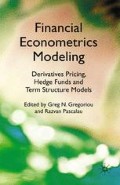Abstract
Emerging stock markets are one of the best areas for investment and have become more accessible to investors in recent years thanks to successive efforts to open up these markets. These markets not only offer investors generous returns and opportunities but also enable them to better diversify their portfolios. These efforts recently led to a significant increase in capital flows toward the region and a rise in emerging market capitalization that reached around 20 percent of world market capitalization in 2000. This also has a considerable impact on the emerging stock market industry. Indeed, in addition to the significant increase in the financial integration of emerging markets into the world market (Bekaert and Harvey 1995), the adjustment dynamics of their asset prices is almost simultaneously governed by internal, regional, and external economic, financial, and political factors (Adler and Qi 2003; Carrieri et al. 2007).
Access this chapter
Tax calculation will be finalised at checkout
Purchases are for personal use only
Preview
Unable to display preview. Download preview PDF.
References
Adler, M. and Qi, R. (2003) “Mexico’s Integration into the North American Capital Market,” Emerging Economic Review, 4 (2): 91–120.
Anderson, H. M. (1997) “Transaction Costs and Nonlinear Adjustment towards Equilibrium in the US Treasury Bill Markets,” Oxford Bulletin of Economics and Statistics, 59 (4): 465–484.
Andrews, D. (1991) “Heteroscedasticity and Autocorrelation Consistent Covariance Matrix Estimation,” Econometrica, 59 (3): 817–858.
Beakert, G. and Harvey, C. (1997) “Emerging Equity Market Volatility,” Journal of Financial Economics, 43 (1): 29–77.
Bekaert, G. and Harvey, C. (1995) “Time Varying World Market Integration,” Journal of Finance, 50 (2): 403–444.
Bekaert, G., Harvey, C., and Ng, A. (2005) “Market Integration and Contagion,” Journal of Business, 78 (1): 39–69.
Bilson, C, Hooper, V, and Jaugietis, M. (2000) “The Impact of Liberalisation and Regionalism upon Capital Markets in Emerging Asian Economies,” International Finance Review, 1 (1): 219–255.
Carrieri, F., Errunza, V., and Hogan, K. (2007) “Characterizing World Market Integration through Time,” Journal of Financial and Quantitative Analysis, 41 (2): 511–540.
Chaouachi, S., Dufrénot, G., and Mignon V (2004) “Modelling the Misalignments of the Dollar-Sterling Real Exchange Rate: A Nonlinear Cointegration Perspective,” Economics Bulletin, 3 (19): 1–11.
De Grauwe, P. and Grimaldi, M. (2006) “Heterogeneity of Agents, Transaction Costs and the Exchange Rate,” Journal of Economic Dynamics and Control, 29 (4): 691–719.
Dufrénot, G. and Mignon, V. (2002) Recent Developments in Nonlinear Cointegration with Applications in Macroeconomics and Finance, Boston, Mass.: Kluwer.
Escribano, A. and Mira, S. (2002) “Nonlinear Error Correction Models,” Journal of Time Series Analysis, 23 (1): 509–522.
Gerard, B., Thanyalakpark, K., and Batten, J. (2003) “Are the East Asian Markets Integrated? Evidence from the ICAPM,” Journal of Economics and Business, 55 (2): 585–607.
Iwatsubo, K., and Inagaki, K. (2007) “Measuring Financial Market Contagion Using Dually-Traded Stocks of Asian Firms,” CEI Working Paper Series No. 14, Institute of Economic Research, Hitotsubashi University, Tokyo, Japan.
Lim, K., Lee, H., and Liew, K. (2003) “International Diversification Benefits in Asian Stock Markets: A Revisit,” Mimeo, Lebuan School of International Business and Finance, Sabah, Malaysia.
Lo, A. W. (1991) “Long-Term Memory in Stock Market Prices,” Econometrica, 59 (5): 1279–1313.
Masih, A. and Masih, R. (1997) “A Comparative Analysis of the Propagation of Stock Market Fluctuations in Alternative Models of Dynamic Causal Linkages,” Applied Financial Economics, 7 (1): 59–74.
Masih, A. and Masih, R. (2001) “Long and Short Term Dynamic Causal Transmission amongst International Stock Markets,” Journal of International Money and Finance, 20 (4): 563–587.
Phylaktis, K. and Ravazzolo, F. (2000) “Stock Prices and Exchange Rate Dynamics,” Mimeo, City University Business School, London.
Phylaktis, K. and Ravazzolo, F. (2005) “Stock Market Linkages in Emerging Markets: Implication for International Portfolio Diversification,” Journal of International Markets and Institutions, 15 (2): 91–106.
Ratanapakon, O. and Sharma, S. (2002) “Interrelationships among Regional Stock Indices,” Review of Financial Economics, 11 (1): 91–108.
Roca, E. and Selvanathan, E. (2001) “Australian and the Three Little Dragons: Are Their Equity Markets Interdependent?” Applied Economic Letters, 8 (3): 203–207.
Sachs, J., Tornell, A., and Velasco, A. (1996) “Financial Crises in Emerging Markets: The Lessons from 1995,” Brookings Papers on Economic Activity, 1: 147–198.
Schwert, G. W. (1989) “Tests for Unit Roots: A Monte Carlo Investigation,” Journal of Business and Economic Statistics, 7 (2): 147–159.
Van Dijk, D., Teräsvirta, T, and Franses, P. H. (2002) “Smooth Transition Autoregressive Models: A Survey of Recent Developments,” Econometric Reviews, 21 (1): 1–47.
Wang, K. M. and Nguyen Thi, T. B. (2007) “Testing for Contagion under Asymmetric Dynamics: Evidence from the Stock Markets between US and Taiwan,” Physica A, 376 (15): 422–432.
Editor information
Editors and Affiliations
Copyright information
© 2011 Mohamed El-Hedi Arouri and Fredj Jawadi
About this chapter
Cite this chapter
Arouri, M.EH., Jawadi, F. (2011). Essays in Nonlinear Financial Integration Modeling: The Philippine Stock Market Case. In: Gregoriou, G.N., Pascalau, R. (eds) Financial Econometrics Modeling: Derivatives Pricing, Hedge Funds and Term Structure Models. Palgrave Macmillan, London. https://doi.org/10.1057/9780230295209_6
Download citation
DOI: https://doi.org/10.1057/9780230295209_6
Publisher Name: Palgrave Macmillan, London
Print ISBN: 978-1-349-32892-5
Online ISBN: 978-0-230-29520-9
eBook Packages: Palgrave Economics & Finance CollectionEconomics and Finance (R0)

